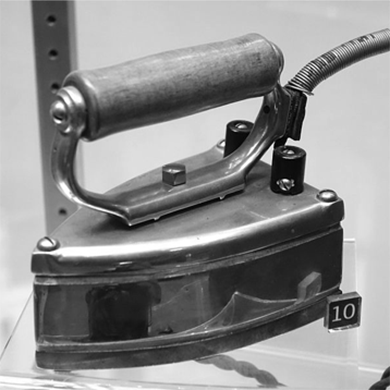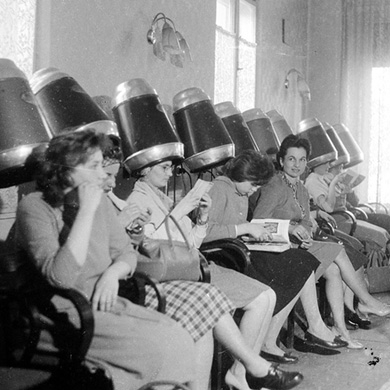Irons, kettles and hairdryers. For households and the hospitality industry alike, these easily accessible products are manufactured by trusted and affordable suppliers such as Corby of Windsor, but they haven’t always looked this way.
Many of us rely on these products day-to-day – but where did they come from?
Following the invention of electricity by Benjamin Franklin back in 1879, a process of manufacturing small appliances followed suit, creating the prototypes of the everyday household essentials we know and love (or, depending on how much linen you need to iron, loathe!).
Appliances on the smaller scale were convenient both for the user and manufacturer, as electricity and these electrical appliances were both expensive to produce and run.
Have you ever wondered where the iron came from? Or the kettle? Or the minibar? Well, let’s find out…

The electric iron has been around since the early 1880s, though its roots lie as far back as 400 B.C. Methods of ironing have been tried and tested throughout the world until long before the electric iron was born.
Traditionally, in Greek history, a round bar would be heated and used to pleat robes and other fabrics. In ancient Rome, Romans would beat fabric with the hopes of straightening out any wrinkles.
In ancient China, hot water or coals would be rubbed over fabrics to smooth lines.
In the early 1900s, technology developed that enhanced the efficiency of the iron, from sourcing effective metal materials that enhanced the smoothing effect, experimenting with gas lines to make the irons much lighter than their predecessors, and even manufacturing wooden handles to prevent the user from burning themselves when using the irons.
Eventually, coinciding with the widespread electrification in America in the 1880s, Henry W. Seely created the first archetype for the electric clothes iron in 1882, revolutionising the clothes iron as we know it today through its efficiency in keeping the iron heated throughout, tackling the tedious task of constantly reheating the iron.
Modernising over the years, adding features such as a steamer, non-stick coatings and the capability for wet and dry ironing, by the 1990s around 14 million irons were sold annually in the USA, the original birthplace of the electric iron.
Electric kettles, like irons, were introduced towards the end of the 19th Century, though their roots lie as far back as 3,500 B.C. in one form or another.
Traditionally, kettles were constructed from iron and placed directly on to a stove or fire until the water boiled, a tradition still found in most American homes by using stove-top kettles due to the general low-wattage in most households, and similarly in Britain by placing stove-top kettles on to traditional appliances such as the Aga.
It wasn’t until 1891, following the surge of experimenting with electricity in small appliances, that electricity was first used as a component to assist in the boiling of water.
At this stage in kettle development, though, water took almost 12 minutes to boil – a huge contrast to the average 160 seconds it takes to boil the kettle nowadays!

Another 30 years later, heating elements were added to the water chamber directly, rather than below the water in a separate compartment, which significantly increased the boiling rate of the water and, in turn, attracted a lot of business to the profitable production of kettles.
Fast forward another 30 years to 1956, the first fully automatic kettle was developed by household name Russell Hobbs, effectively bringing the kettle into the modern era. In the 21st Century, it’s approximated around 7 million kettles are sold each year in the UK – that’s a lot of cup of teas!

The concept of a mechanism that can be used to dry hair was born almost 130 years ago, when French stylist and inventor Alexander Godfrey created the prototype for a large, seated blow-dry type machine that consisted of a bonnet attached to the chimney pipe of a gas stove!
It was not for another 30 years, however, that the first handheld and portable hairdryer became available on the market in 1920.
Unlike the modern-day hairdryer, requiring minimum time and minimal effort, traditional hairdryers were big, bulky (weighing approximately 2 pounds) and seem rather primitive compared to this day and age.
Not to mention the lack of actual drying power, and frequent overheating, meaning results were a lot slower than nowadays.
However, by the 1960s, there had been a dramatic improvement in the quality of hair-drying technology. Their design became more practical, and attractive, far removed from their futuristic-looking predecessors. Nowadays, hairdryers are lightweight, agile and easy-to-use making them a staple in households and most accommodation.
Traditionally a popular addition to the higher-end hotel, the minibar first originated in Germany in the early 1960s. Stocked with food and drink refreshments, the minibar fridge became an instant hit with hoteliers and guests alike, featuring in most rooms from 1963 onwards.
However, it wasn’t until 1974, a good 39,000 feet in the air, when Hong Kong Hilton’s Food and Beverage manager Robert Arnold had the bright idea of adding small, individual bottles of liquor to the mini fridges upon being served a mini bottle of an alcoholic beverage on a flight.
Upon returning to China, the minibar continued to boom, with the Hong Kong Hilton Hotel itself seeing a 500% surge in room-service drink purchases!
